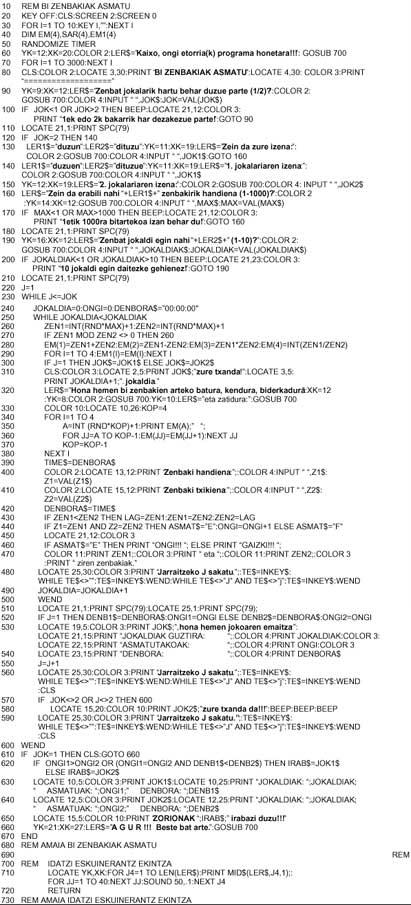Inventing the two numbers
We have selected a number game for this number. However, and in order to get out of the path of the usual systematic solutions, equations, etc., what is intended with this game is to work logic and intuition. The program will provide the sum, difference, product and quotient between two randomly chosen numbers, and the user will have the function of figuring out what those two numbers are. Since this data is to be provided mixed, it is necessary to use logic in order to know the result of each operation. Each delegate the resolution of the relationships found.
In addition, and without too much competition, the time it takes to invent the numbers has been taken into account.
On the other hand, we will mention that a maximum of two players can participate.
To see to what extent you are capable!
Act! News

- 10-70: Launch and presentation of the program.
- 80-210: Game definition: The number of players (90-100), the name(s) of the player(s) (120-150), the highest number(s) to be used (160-180) and the number(s) of plays (190-210) to be played must be defined.
- 220-600: In this cycle the session of each player is controlled. The number of hits and the runtime of the session will be taken into account. To do this, the control of each move, that is, the answer to questions and the verification of the answer is done in another cycle.
- 250-500: Two numbers between 1 and the maximum number chosen will be randomly extracted, being a divisible condition to be met. The user will be shown
the following results, but not mixed in this order, but (320-380) and he himself must guess the two numbers used by the computer (400-410). When controlling time, only the time intervals from the moment each question is asked will
be taken into account until it introduces the answers to make the measurement as accurate as possible. - 510-590: At the end of the session, the player who is playing will be explained on screen the results obtained and the other player will be given the turn if they are two.
- 250-500: Two numbers between 1 and the maximum number chosen will be randomly extracted, being a divisible condition to be met. The user will be shown
- 610-670: If it is a single player, it is enough to show the results obtained by him, but in the case of two is indicated the winner between both. The first point to consider will be the number of successes to
determine the winner. If this number is the same for the two players, the winner will be the least time.
NOTE: This program has used a new sentence and a new function to control time. In the computer you can enter the time in two ways: typing when you turn on the computer or giving a value to the variable TIME$ within a program.
E.g. = TIME$ = “00:00:00”
Once started the watch will continue until the computer is turned off. Therefore, and since in this case we are interested in measuring very specific times, we have had to achieve the effect of stopping the clock and starting it again using an auxiliary variable (TIME $).
The TIME$ function returns the time the computer has. Therefore, TIME$ = TIMES $ will be enough to stop the clock. The resumption of the clock can be made by the TIME$ = TIME$ judgment.





